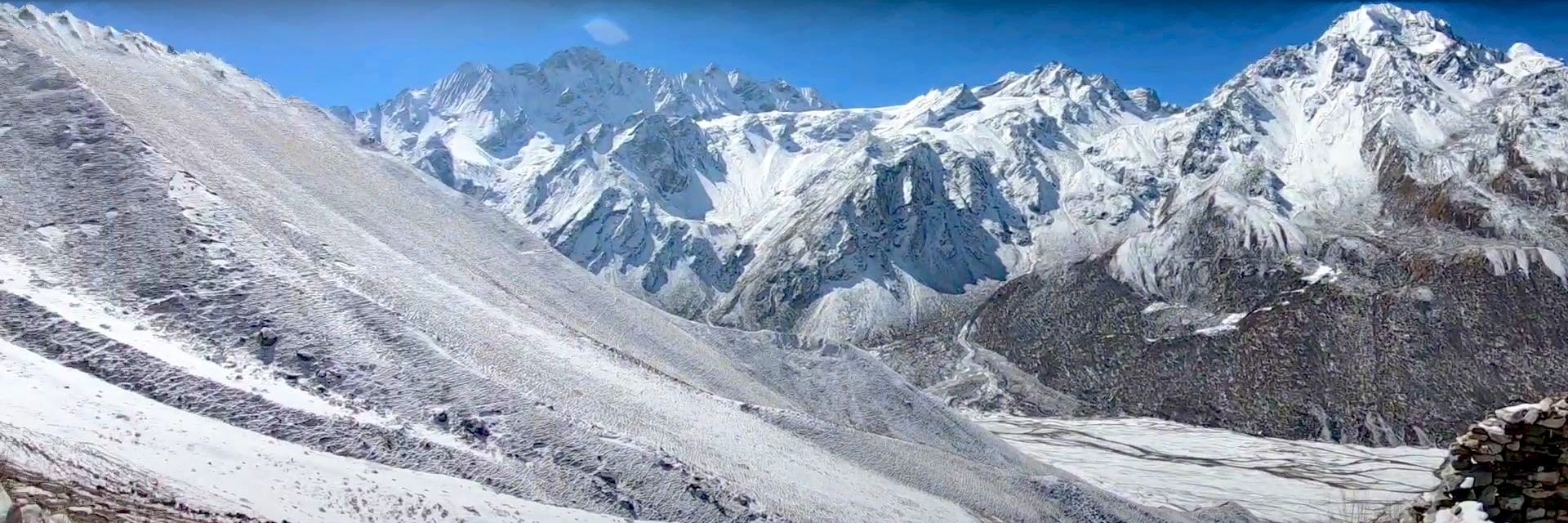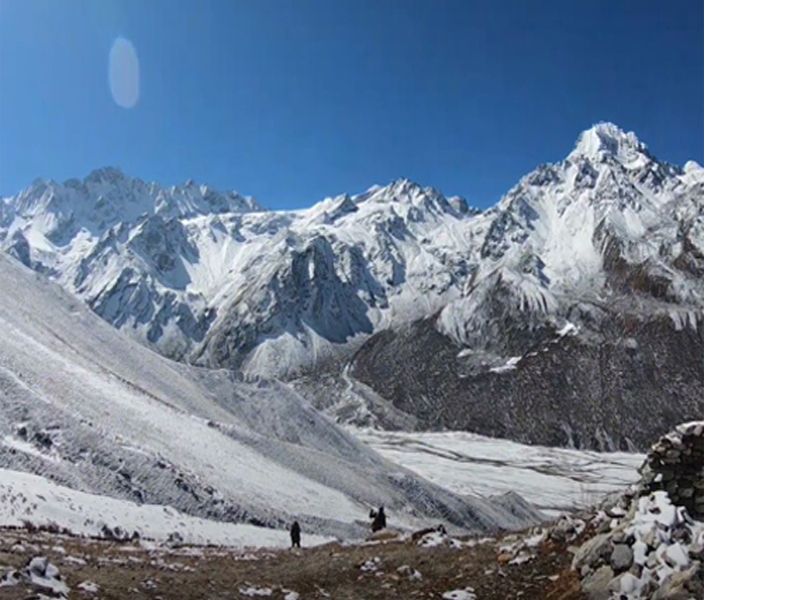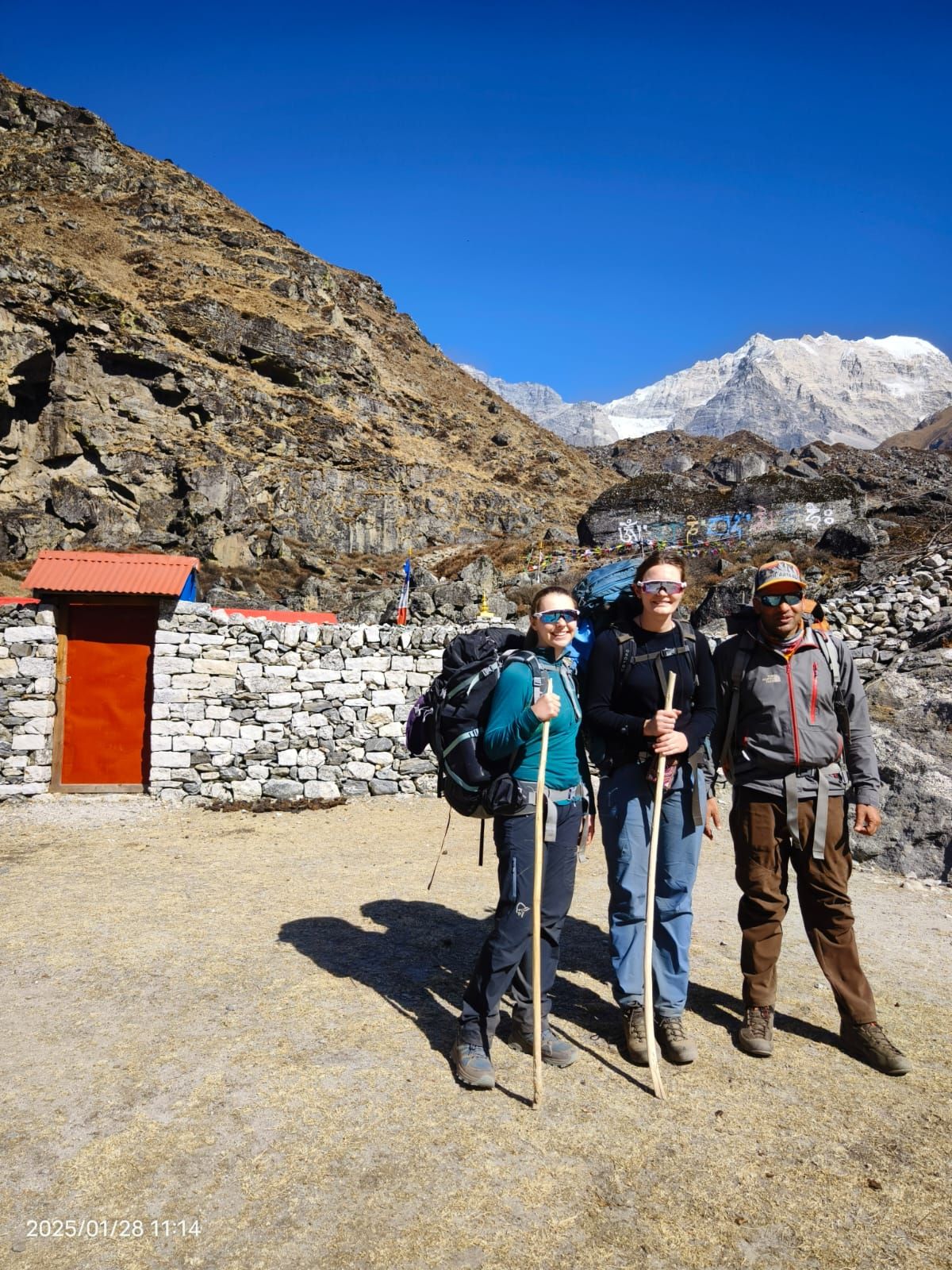Overview of Langtang Valley Trek
The Langtang Valley trek in Nepal begins near Kathmandu, where it borders Tibet. Travelers who visit this destination can enjoy traditional village culture together with Himalayan Mountain views.
Trekkers can reach Syabrubesi by spending seven hours in a vehicle from Kathmandu. Throughout the trail, trekkers experience stunning Langtang Lirung (7227m) mountain views, passing through dense forests and meeting both rivers and small communities.
Kyanjin Gompa (3,870m) is a beautiful Buddhist monastery surrounded by breathtaking mountain panorama. The mountaintop viewpoint Tserko Ri (4,984m) attracts most tourists to view stunning Himalayan sunrises.
Visitors can engage with Tamang and Tibetan people who live according to traditional ways while teaching visitors about their cultural practices. Travelers at the Kyanjin cheese factory can experience traditional local cuisine, watching the staff make yak cheese.
The best time to visit Langtang Valley is from March to May and September to November to experience perfect mountain views and clear weather conditions.
Tourists staying at basic accommodations built by local families can find overnight stays in their teahouses. To embark on this trek, one requires both documentation from Langtang National Park and a TIMS card alongside basic permits.
Participating in the Langtang Valley Trekking allows one to observe stunning views alongside local traditions throughout Himalayan peace terrains.
Major attractions of Langtang Valley Trek
Two important landmarks stand out during the Langtang Valley Trek: the 3,870-meter-tall sacred monastery of Kyanjin Gompa and the prominent viewpoint at Tserko Ri, which reaches 4,984 meters above sea level.
People visiting Langtang Village get to meet local Tamang and Tibetan populations tasting fresh yak cheese produced at the Kyanjin cheese factory.
The trail combines snowy peaks, waterfalls, forested areas, and the rare red panda population inside Langtang National Park.
Scenic Mountain Views
The snowy peaks of Langtang Lirung (7,227m) and other high peaks, along with numerous other peaks, are viewable from the Langtang Valley Trek. People watching the Himalayas can find ideal viewing positions at Tserko Ri (4,984m) and Kyanjin Gompa (3,870m).
Explore Langtang National Park
The protected Langtang National Park shows magnificent views of mountains alongside lush forests demonstrating both flowing rivers and glacial features.
The protected area views unique wildlife species, such as red pandas and snow leopards, alongside Himalayan black bears and multiple bird species. Trekkers who walk this trail get to enjoy scenic pine and rhododendron forests while crossing beautiful wooden bridges.
Visit Kyanjin Gompa
The Kyanjin Gompa (3,870m) monastery lies below snowy peaks that surround this magnificent Buddhist structure. This peaceful spot lets trekkers experience the sights of spinning wheels along with monks chanting and prayer flags.
Beyond visiting Kyanjin cheese factory trekkers can experience fresh yak cheese while taking in breathtaking mountain views.
Epic view point Tserko ri
Travelers reach Tserko Ri (4,984m) for breathtaking Himalayan sunrise views. Trekkers begin their morning hikes to experience snowy peaks, glaciers, and deep valleys surrounding them.
The top offers a magnificent 360-degree view of Langtang mountains which establishes this place as an essential destination.
Langtang Glacier
Langtang Glacier exists as a powerful glacial river forming within the Langtang Valley. During Kyanjin Gompa treks, visitors can observe the Langtang glacier combined with its streams.
Yala Peak Climbing
New climbers entering the Langtang mountains start their journey from the Yala Peak summit at 5,520 meters. After reaching Yala Peak the beautiful sights of Langtang Lirung and Shishapangma (Tibet) can be seen.
Experience Tamang Culture
The Tamang people in the Langtang Valley practice Tibetan culture and welcome visitors to experience their culture. Stone houses are decorated with different colors and they perform religious ceremonies through dance and music.
You can eat traditional yak cheese while exploring their Buddhist heritage and observing their way of living.
Rivers and Waterfalls
The journey through Langtang Valley features numerous running rivers and beautiful waterfalls across the trekking path. Fast-flowing rivers provide clear, cold water, while waterfalls on high cliffs create beautiful sounds.
Langtang Valley Trekking for Beginners
The Langtang Valley Trek is an optimal expedition for new trekkers looking to see Himalayan wonders through a manageable trekking adventure.
Beginners with moderate trekking skills can complete this 9 to 10-day path, which departs from Syabrubesi. The trekker's route takes you through rural villages and wooded areas, offering panoramic views of snow peaks, including Langtang Lirung.
Heading to Kyanjin Gompa let you explore the peaceful monastery before attempting to climb Tserko Ri peak for incredible viewpoints. This area features stunning rivers as well as mesmerizing waterfalls and scenic glaciers.
During the trek, you can take breaks in basic teahouses that serve local Tamang food including yak cheese. The prime trekking season for Langtang Valley is spring from March through May and autumn and extends from September through November when weather conditions are optimal.
How to prepare for Langtang Valley Trek?
The Langtang Valley trek can be completed by getting physically ready through daily walks and hikes before starting your trek.
The cold mountain during the night requires you to carry lightweight, warm clothing. You need to bring Hiking boots that provide comfort and safety during trekking activities. Pack your backpack with essential items, which include water, snacks, sunscreen and a first-aid kit.
To begin your journey, you need both permits from the Langtang National Park and also the TIMS card. Professionals who guide tourists play an essential role since they both maintain safety and provide direction during the entire trek.
During your final stage, enjoy the beautiful scenery while making sure to drink water regularly.
Langtang Valley Trek Group Join
The Langtang Valley Trek becomes more accessible and safer when joining an organized group. Multiple trekking agencies based in Kathmandu arrange group trips that provide guidance to fellow trekkers during their journey.
Many trekking groups have 6 to 12 participants which creates a communal and friendly atmosphere. Group trek is beneficial as they arrange all necessary permits as well as accommodations and meals.
The arrangement permits along with accommodation and meals are arranged by guides so you can rest easy without any planning responsibilities.
Your guide will help you both navigate the trail as well as keep you safe particularly in challenging sections of the trek.
When you participate in group treks, the expenses of transportation permits and food become affordable through shared costs. Trekking with others allows you to experience your adventure without the concern of loneliness or stress while making new friends.
Absolute beginners benefit from joining group treks because they receive constant guidance throughout their expedition.
Langtang Valley Trek Altitude
Throughout the Langtang Valley Trekking, you will experience a sequence of rising elevations from 1,460 meters (4,790 feet) in Syabrubesi to 3,870 meters (12,694 feet) in Kyanjin Gompa which stands as the trek's peak altitude.
The trail takes travelers through several villages including Langtang Village at 3,430 meters and Lama Hotel at 2,480 meters.
Altitude sickness can be prevented through careful movement at higher altitudes. Step-by-step altitude adjustment becomes possible through this gradual climbing experience.
Tserko Ri stands at 4,984 meters and is the trek's highest destination, where visitors can enjoy stunning mountain landscapes.
This trek requires moderate physical ability from people who exercise regularly regardless of the mountain elevation. Your body requires rest days at high altitudes to adapt to the conditions.
Langtang Valley Trek Extension and Alternatives
Various exceptional locations lie within the Langtang Valley Trek, which makes you experience Nepal's gorgeous terrain and cultural heritage.
Langtang Tamang Heritage Trek
Travelers along the Langtang Tamang Heritage route get to experience spectacular mountain views as well as deep cultural encounters with local communities.
Travelers beginning in Syabrubesi can walk through Briddim and Rimche to experience Buddhist monasteries and see traditional stone architecture while learning about local traditions.
Travellers with good fitness levels can start this moderate trek to see Langtang Lirung from a fantastic viewpoint.
As you travel through the path, you will encounter forests river valleys, and agricultural terraces while experiencing the welcoming spirit of Tamang peoples.
Langtang Gosainkunda Trek
Trekking along the Langtang Gosaikunda Trail throughout Nepal exposes travelers to the divine Gosaikunda Lake while exploring beautiful sights.
The Langtang Gosaikunda Trek begins in Syabrubesi and goes through forests and villages, where stunning landscapes surround the path.
Travelers can experience stunning vistas because this path reveals three primary mountain ranges – Langtang Lirung, Manaslu and Ganesh Himal.
The trail leads through Tamang settlements so trekkers can witness their traditional ways of life and meet the friendly local people.
Langtang Gosainkunda Trek via Lauri Binayak Pass
The Langtang Gosaikunda Trek lies ahead for those who cross Laurebinayak Pass during their exploration.
Passing through Syabrubesi you can access Langtang Valley by walking past Lama Hotel and Langtang Village to observe Langtang Lirung.
Those hiking toward Gosaikunda Lake will cross Laurebinayak Pass (4610 meters) to view landscapes of Manaslu, Ganesh Himal and Langtang Lirung.



